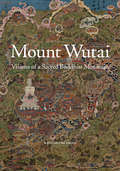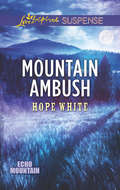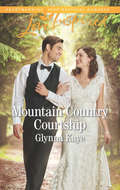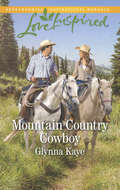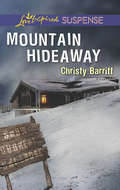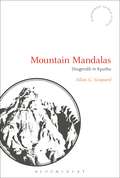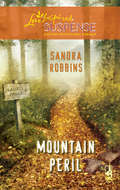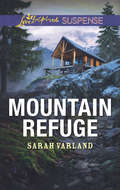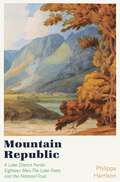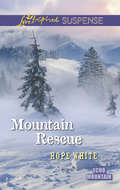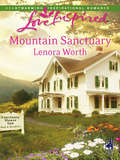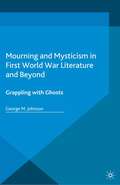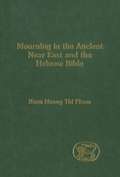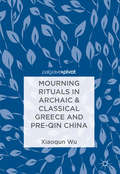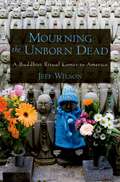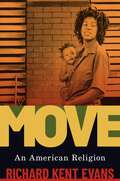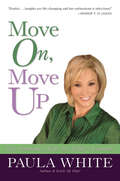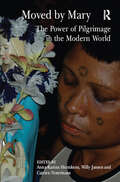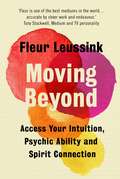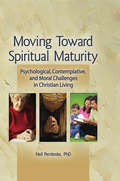- Table View
- List View
Mount Wutai: Visions of a Sacred Buddhist Mountain
by Wen-shing ChouThe northern Chinese mountain range of Mount Wutai has been a preeminent site of international pilgrimage for over a millennium. Home to more than one hundred temples, the entire range is considered a Buddhist paradise on earth, and has received visitors ranging from emperors to monastic and lay devotees. Mount Wutai explores how Qing Buddhist rulers and clerics from Inner Asia, including Manchus, Tibetans, and Mongols, reimagined the mountain as their own during the eighteenth and nineteenth centuries.Wen-Shing Chou examines a wealth of original source materials in multiple languages and media--many never before published or translated—such as temple replicas, pilgrimage guides, hagiographic representations, and panoramic maps. She shows how literary, artistic, and architectural depictions of the mountain permanently transformed the site's religious landscape and redefined Inner Asia's relations with China. Chou addresses the pivotal but previously unacknowledged history of artistic and intellectual exchange between the varying religious, linguistic, and cultural traditions of the region. The reimagining of Mount Wutai was a fluid endeavor that proved central to the cosmopolitanism of the Qing Empire, and the mountain range became a unique site of shared diplomacy, trade, and religious devotion between different constituents, as well as a spiritual bridge between China and Tibet.A compelling exploration of the changing meaning and significance of one of the world's great religious sites, Mount Wutai offers an important new framework for understanding Buddhist sacred geography.
Mount Wutai: Visions of a Sacred Buddhist Mountain
by Wen-shing ChouThe northern Chinese mountain range of Mount Wutai has been a preeminent site of international pilgrimage for over a millennium. Home to more than one hundred temples, the entire range is considered a Buddhist paradise on earth, and has received visitors ranging from emperors to monastic and lay devotees. Mount Wutai explores how Qing Buddhist rulers and clerics from Inner Asia, including Manchus, Tibetans, and Mongols, reimagined the mountain as their own during the eighteenth and nineteenth centuries.Wen-Shing Chou examines a wealth of original source materials in multiple languages and media--many never before published or translated—such as temple replicas, pilgrimage guides, hagiographic representations, and panoramic maps. She shows how literary, artistic, and architectural depictions of the mountain permanently transformed the site's religious landscape and redefined Inner Asia's relations with China. Chou addresses the pivotal but previously unacknowledged history of artistic and intellectual exchange between the varying religious, linguistic, and cultural traditions of the region. The reimagining of Mount Wutai was a fluid endeavor that proved central to the cosmopolitanism of the Qing Empire, and the mountain range became a unique site of shared diplomacy, trade, and religious devotion between different constituents, as well as a spiritual bridge between China and Tibet.A compelling exploration of the changing meaning and significance of one of the world's great religious sites, Mount Wutai offers an important new framework for understanding Buddhist sacred geography.
Mountain Ambush: Mountain Ambush Mountain Hideaway (Echo Mountain #6)
by Hope WhiteMARKED FOR MURDER
Mountain Country Courtship: Their Amish Reunion Counting On The Cowboy Mountain Country Courtship (Hearts of Hunter Ridge #6)
by Glynna KayeHis Hometown Romance
Mountain Country Cowboy: Their Amish Reunion Counting On The Cowboy Mountain Country Courtship (Hearts of Hunter Ridge #5)
by Glynna KayeSecond-Chance Daddy
Mountain Hideaway: Mountain Ambush Mountain Hideaway (Mills And Boon Love Inspired Suspense Ser.)
by Christy BarrittNo safe haven
Mountain Mandalas: Shugendo in Kyushu (Bloomsbury Shinto Studies)
by Allan G. GrapardIn Mountain Mandalas Allan G. Grapard provides a thought-provoking history of one aspect of the Japanese Shugendo tradition in Kyushu, by focusing on three cultic systems: Mount Hiko, Usa-Hachiman, and the Kunisaki Peninsula. Grapard draws from a rich range of theorists from the disciplines of geography, history, anthropology, sociology, and humanistic geography and situates the historical terrain of his research within a much larger context.This book includes detailed analyses of the geography of sacred sites, translations from many original texts, and discussions on rituals and social practices. Grapard studies Mount Hiko and the Kunisaki Peninsula, which was very influential in Japanese cultural and religious history throughout the ages. We are introduced to important information on archaic social structures and their religious traditions; the development of the cult to the deity Hachiman; a history of the interactions between Buddhism and local cults in Japan; a history of the Shugendo tradition of mountain religious ascetics, and much more.Mountain Mandalas sheds light on important aspects of Japan's religion and culture, and will be of interest to all scholars of Shinto and Japanese religion. Extensive translations of source material can be found on the book's webpage.
Mountain Mandalas: Shugendo in Kyushu (Bloomsbury Shinto Studies)
by Allan G. GrapardIn Mountain Mandalas Allan G. Grapard provides a thought-provoking history of one aspect of the Japanese Shugendo tradition in Kyushu, by focusing on three cultic systems: Mount Hiko, Usa-Hachiman, and the Kunisaki Peninsula. Grapard draws from a rich range of theorists from the disciplines of geography, history, anthropology, sociology, and humanistic geography and situates the historical terrain of his research within a much larger context.This book includes detailed analyses of the geography of sacred sites, translations from many original texts, and discussions on rituals and social practices. Grapard studies Mount Hiko and the Kunisaki Peninsula, which was very influential in Japanese cultural and religious history throughout the ages. We are introduced to important information on archaic social structures and their religious traditions; the development of the cult to the deity Hachiman; a history of the interactions between Buddhism and local cults in Japan; a history of the Shugendo tradition of mountain religious ascetics, and much more.Mountain Mandalas sheds light on important aspects of Japan's religion and culture, and will be of interest to all scholars of Shinto and Japanese religion. Extensive translations of source material can be found on the book's webpage.
Mountain Peril (Mills And Boon Love Inspired Ser.)
by Sandra RobbinsAccording to an anonymous message, a young woman is going to be murdered in the North Carolina mountains. When a body is found, Danielle Tyler is shocked to learn it's her student–the third person in her life to meet an untimely death.
Mountain Refuge: Thread Of Revenge Plain Jeopardy Mountain Refuge (Mills And Boon Love Inspired Suspense Ser.)
by Sarah VarlandALASKAN RESCUER
Mountain Republic: A Lake District Parish - Eighteen Men, The Lake Poets and the National Trust
by Philippa HarrisonAn affectionate but meticulously researched history of one of the most beautiful and best-loved corners of England – Crosthwaite Parish, nestling deep within the mountains and valleys of the Lake District.'A unique contribution to English history' Hunter Davies'A delightful, refreshingly written book, attentive to social detail and telling the only story that matters – history' Simon Jenkins'A wonderful book' Margaret Drabble'A completely fresh perspective on the Lakes and Lake Poets... I hugely enjoyed it' Andrew MarrBounded by the peaks of Scafell, Skiddaw and Helvellyn, and embracing such well-known landmarks as Borrowdale, Derwentwater and Keswick, it lies within the heart of the Lake Poets' landscape and its rugged terrain excites passion in all those who know it.The Parish also boasts a remarkable history. Its 90 square miles were governed, from medieval times, by eighteen annually chosen 'customary tenants'; ancestors of the people who later prompted Wordsworth's portrayal of the area as 'a perfect Republic of Shepherds and agriculturalists'. His fellow poet Robert Southey lived within the Parish for forty years, was an active parishioner and rests in St Kentigern's churchyard. Here he is given his rightful position as a Lake Poet. In the nineteenth century, the Victorian state killed off the old parish system, sweeping away the egalitarian rule of the Eighteen Men. But a degree of redemption was at hand. Canon Rawnsley, vicar of Crosthwaite from 1883, pledged to defend the Lake District for future generations. So the Parish was at the heart of the creation of the National Trust and blazed a trail for a wider movement to preserve the English landscape.Writing with a historian's rigour and bearing aloft the banner of the Lake District statesmen, Philippa Harrison has produced a magisterial and fascinating record of a parish with a unique social, cultural and aesthetic resonance in English history.
Mountain Rescue: Smoky Mountain Investigation Mountain Rescue (Echo Mountain #1)
by Hope WhiteSECRETS OF THE MOUNTAIN
Mountain Sanctuary (Mills And Boon Love Inspired Ser.)
by Lenora WorthA Fresh Start Sometimes Stella Forsythe's shaky faith held her back and made her doubt herself…and second chances.
Mourning and Mysticism in First World War Literature and Beyond: Grappling with Ghosts
by George M. JohnsonThis book traces how iconic writers - including Arthur Conan Doyle, J.M. Barrie, Rudyard Kipling, Virginia Woolf, Wilfred Owen, and Aldous Huxley - shaped their response to the loss of loved ones in the First World War through their embrace of mysticism.
Mourning in the Ancient Near East and the Hebrew Bible (The Library of Hebrew Bible/Old Testament Studies)
by Xuan Huong PhamCommentators are often disturbed by the presence of various speakers in the three poems of Lamentations 1 and 2, and Isaiah 51.9-52.2, the change of speakers being thought to disrupt the flow of ideas. This study shows that a close reading of all three poems in the light of their mourning ceremony setting displays a clear and consistent flow of thought. Purported cases of 'disruption' now fit into their present context as moments in which different mourners voice their pains and their questions aloud, and bring their incomprehensible sufferings to Yahweh their God and the creator of all.
Mourning Rituals in Archaic & Classical Greece and Pre-Qin China
by Xiaoqun WuThis pivot compares mourning rituals in Archaic & Classical Greece and Pre-Qin China to illustrate some of the principles and methods used in comparative studies. It focuses on three main aspects of mourning of the dead before burial — lamentation, mourners’ gestures and behaviors, and mourning apparel — to demonstrate the cultural function, purpose, and social influence of mourning. A key comparative study of rituals at the heart of both Western and Chinese culture, this text highlights the cultural function and social influence of rituals of two ancient peoples and will be of interest to all scholars of comparative religion, sociology and anthropology.
Mourning Rituals in Archaic & Classical Greece and Pre-Qin China
by Xiaoqun WuThis pivot compares mourning rituals in Archaic & Classical Greece and Pre-Qin China to illustrate some of the principles and methods used in comparative studies. It focuses on three main aspects of mourning of the dead before burial — lamentation, mourners’ gestures and behaviors, and mourning apparel — to demonstrate the cultural function, purpose, and social influence of mourning. A key comparative study of rituals at the heart of both Western and Chinese culture, this text highlights the cultural function and social influence of rituals of two ancient peoples and will be of interest to all scholars of comparative religion, sociology and anthropology.
Mourning the Unborn Dead: A Buddhist Ritual Comes to America
by Jeff WilsonMany Western visitors to Japan have been struck by the numerous cemeteries for aborted fetuses, which are characterized by throngs of images of the Bodhisattva Jizo, usually dressed in red baby aprons or other baby garments, and each dedicated to an individual fetus. Abortion is common in Japan and as a consequence one of the frequently performed rituals in Japanese Buddhism is mizuko-kuyo, a ceremony for aborted and miscarried fetuses. Over the past forty years, mizuko-kuyo has gradually come to America, where it has been appropriated by non-Buddhists as well as Buddhist practitioners. In this book, Jeff Wilson examines how and why Americans of different backgrounds have brought knowledge and performance of this Japanese ceremony to the United States. Drawing on his own extensive fieldwork in Japan and the U.S., as well as the literature in both Japanese and English, Wilson shows that the meaning and purpose of the ritual have changed greatly in the American context. In Japan, mizuko-kuyo is performed to placate the potentially dangerous spirit of the angry fetus. In America, however, it has come to be seen as a way for the mother to mourn and receive solace for her loss. Many American women who learn about mizuko-kuyo are struck by the lack of such a ceremony and see it as filling a very important need. Ceremonies are now performed even for losses that took place many years ago. Wilson's well-written study not only contributes to the growing literature on American Buddhism, but sheds light on a range of significant issues in Buddhist studies, interreligious contact, women's studies, and even bioethics.
MOVE: An American Religion
by Richard Kent EvansWhat is a religion? That is the question that Richard Kent Evans attempts to answer in this book. He does so through the story of MOVE, a little-known group with a fascinating story. MOVE emerged in Philadelphia in the early 1970s. It was a small, mostly African American group devoted to the teachings of John Africa. In 1985, the Philadelphia Police Department -- working in concert with federal and state law enforcement -- attacked a home that "MOVE people" as they preferred to be known, shared in West Philadelphia. Hundreds of police officers and firefighters laid siege to the building using tear gas, ten thousand rounds of ammunition, and improvised explosives. Most infamously, a police officer riding in a helicopter dropped a bomb containing C-4 explosives, which he had acquired from the FBI, onto the roof of the MOVE house. The bomb started a fire, which officials allowed to spread in hopes of chasing the MOVE people out of the house. Police officers fired upon those who tried to escape the flames. Eleven MOVE people died in the attack, including John Africa. Five of those who died were children. In this book, Richard Kent Evans tells the story of MOVE -- a story that has been virtually lost outside of Philadelphia. What was MOVE? Many MOVE members thought of themselves as belonging to a religion, and they sought legal recognition. But to others, including other religious groups like the Quakers and, more importantly, the courts, MOVE was anything but a religion. Evans dives deep into how we decide what constitutes a genuine religious tradition, and the enormous consequences of that decision.
MOVE: An American Religion
by Richard Kent EvansWhat is a religion? That is the question that Richard Kent Evans attempts to answer in this book. He does so through the story of MOVE, a little-known group with a fascinating story. MOVE emerged in Philadelphia in the early 1970s. It was a small, mostly African American group devoted to the teachings of John Africa. In 1985, the Philadelphia Police Department -- working in concert with federal and state law enforcement -- attacked a home that "MOVE people" as they preferred to be known, shared in West Philadelphia. Hundreds of police officers and firefighters laid siege to the building using tear gas, ten thousand rounds of ammunition, and improvised explosives. Most infamously, a police officer riding in a helicopter dropped a bomb containing C-4 explosives, which he had acquired from the FBI, onto the roof of the MOVE house. The bomb started a fire, which officials allowed to spread in hopes of chasing the MOVE people out of the house. Police officers fired upon those who tried to escape the flames. Eleven MOVE people died in the attack, including John Africa. Five of those who died were children. In this book, Richard Kent Evans tells the story of MOVE -- a story that has been virtually lost outside of Philadelphia. What was MOVE? Many MOVE members thought of themselves as belonging to a religion, and they sought legal recognition. But to others, including other religious groups like the Quakers and, more importantly, the courts, MOVE was anything but a religion. Evans dives deep into how we decide what constitutes a genuine religious tradition, and the enormous consequences of that decision.
Move On, Move Up: Turn Yesterday's Trials into Today's Triumphs
by Paula WhiteA woman who has experienced both tragedy and triumph, Paula White shares hope with those facing life's trials. Paula opens her heart to offer personal testimonies and key passages of Scripture that will equip readers to discover purpose in their pain and to overcome any challenge that crosses their path. It's not about what happens to us, it's about what happens in us. Failure is not final. We have the power to:- Renew our minds- Transition from trial to testimony- Discover God's pattern for our livesMost important, Paula teaches readers to never quit. Tough times don't last-tough people do! What are you waiting for? Grab hold of the victory God promises. It's time to MOVE ON, MOVE UP.
Moved by Mary: The Power of Pilgrimage in the Modern World
by Willy JansenThe Virgin Mary continues to attract devotees to her images and shrines. In Moved by Mary, anthropologists, geographers and historians explore how people and groups around the world identify and join with Mary in their struggle against social injustice, and how others mobilize Mary to impose ideas and rules and legitimize acts of violence and suppression. Far from an outdated practice of little relevance to the modern world, Marian pilgrimage expresses the deep and urgent concerns of a wide range of people. With examples of Marian pilgrimages from all over the world, Moved by Mary explores the ways in which men and women of different ages and religious, political, social-economic and ethnic backgrounds empower themselves to deal with modern-day issues with Mary´s help. The ethnographic cases reveal the cultural and devotional variation of Marian pilgrimage, but also global similarities. Collectively, the contributors to Moved by Mary show how in many places religion dramatically suffuses everyday life.
Moved by Mary: The Power of Pilgrimage in the Modern World
by Willy JansenThe Virgin Mary continues to attract devotees to her images and shrines. In Moved by Mary, anthropologists, geographers and historians explore how people and groups around the world identify and join with Mary in their struggle against social injustice, and how others mobilize Mary to impose ideas and rules and legitimize acts of violence and suppression. Far from an outdated practice of little relevance to the modern world, Marian pilgrimage expresses the deep and urgent concerns of a wide range of people. With examples of Marian pilgrimages from all over the world, Moved by Mary explores the ways in which men and women of different ages and religious, political, social-economic and ethnic backgrounds empower themselves to deal with modern-day issues with Mary´s help. The ethnographic cases reveal the cultural and devotional variation of Marian pilgrimage, but also global similarities. Collectively, the contributors to Moved by Mary show how in many places religion dramatically suffuses everyday life.
Moving Beyond: Access Your Intuition, Psychic Ability and Spirit Connection
by Fleur LeussinkFrom LA's psychic medium to the A-list stars comes Moving Beyond - a guide to tapping into your intuition, reading signs and communicating with spirit.Fleur Leussink has been named one of the best mediums by LA Magazine and her innate ability to communicate with loved ones 'in spirit' has connected countless families all over the world. Through inspirational and educational stories, Moving Beyond answers the questions that Fleur receives every day, taking the mystery out of mediumship.Moving Beyond is the perfect book for anyone desiring to know their own spirit and feel a reassuring connection to the people they have lost. Using anecdotes from over 15,000 readings and her own life story, Fleur provides exercises and steers so you can practice getting closer to connecting with spirit yourself.Moving Beyond will help you to:- Understand how intuition and spirit communication works.- Have a practical understanding of your own intuition and how to recognise a connection with loved ones.- Explore larger questions, such as 'what is my purpose?' and 'do we have free will?''There are a handful of truly gifted mediums in the world, and Fleur is one of them.' - Lana Del Rey'Fleur is one of the best mediums in the world.' - Tony Stockwell
Moving Toward Spiritual Maturity: Psychological, Contemplative, and Moral Challenges in Christian Living
by Neil PembrokeThree &’windows&’ to spiritual maturity How can a faithful Christian avoid stagnating in their spiritual development? Moving Toward Spiritual Maturity: Psychological, Contemplative, and Moral Challenges in Christian Living explores effective ways in which Christian discipleship can grow in spiritual maturity. This thoughtful, integrative roadmap explains the journey through three interrelated perspectives, or &’windows,&’ psychotherapeutic psychology, prayer and contemplation, and moral theology. The author uses numerous examples from everyday life to make the reflections interesting and practical. Unlike other books on Christian spirituality, this book is more challenging and sophisticated in its depth of thought. Spiritual maturity is a process that begins when a person accepts Jesus Christ as Savior, and progresses ongoing through a Christian&’s life. Moving Toward Spiritual Maturity discusses in detail the challenges one must face, including the sustained, in-depth, and faithful attention to psychological wholeness, conversion to the true self, and interpersonal and social responsibility. Effective strategies are given through example and personal story, making understanding of the principles easier. This reflection on Christian maturity helps readers to focus directly on the personal issues all must face when attuning to the Spirit of Christ. Topics in Moving Toward Spiritual Maturity include: reforming the wayward self moral or guilt-based perfectionism achievement or shame-based perfectionism the two types of conversion responsibility and accountability agape and the loving of oneself three virtues at the heart of the responsible life-integrity, courage, and compassion virtues as habits the relationship between personal fulfillment and the Christian vocation Moving Toward Spiritual Maturity is a unique look at the path toward spiritual maturity, and is challenging, thoughtful reading for laypersons, ministers, priests, and theological students.
